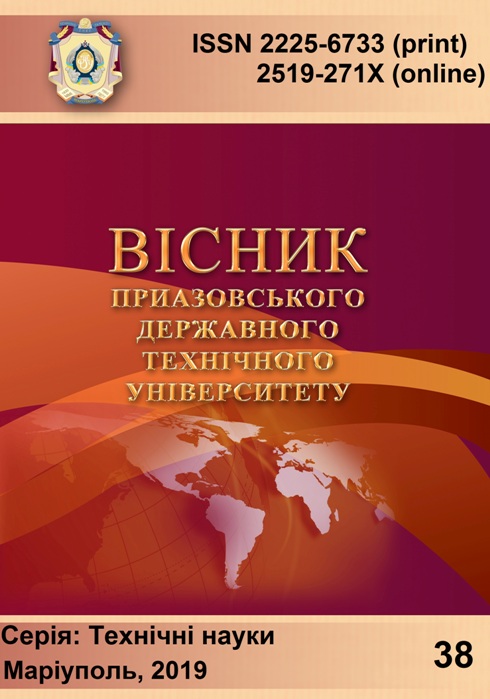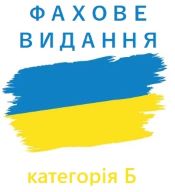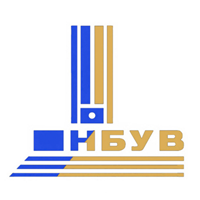Дослідження температури плавлення шлаків, що використовуються у процесах спеціальної електрометалургії
DOI:
https://doi.org/10.31498/2225-6733.38.2019.181247Ключові слова:
шлак, плавлення, твердіння, хімічний склад, температура, мікроскоп, тигельАнотація
Розвиток металургійної промисловості України в значній мірі залежить від експорту сталі високої якості, яку виплавляють способами спеціальної електрометалургії. Якість металу, що одержують в електрошлакових процесах, визначається технологічними властивостями шлаків, що використовуються. В електрошлакових процесах шлак, що являється джерелом теплоти, виконує низку інших важливих функцій: рафінує метал від неметалевих включень, газів та шкідливих домішок, захищає рідкий метал від взаємодії з атмосферою, забезпечує якісну поверхню злитка. З метою застосування шлаків раціонального хімічного складу виконали експериментальні дослідження інтервалів плавлення шлаків оптичним та контактним способами. Оптичні дослідження виконували на високотемпературному нагрівальному мікроскопіМНО-2, що вироблено фірмою «Carl Zeiss». Мікроскоп був модернізований: внутрішній гальванометр, що давав похибки вимірювань, замінили зовнішнім гальванометром, який був з’єднаний з платинородій-платиновою термопарою. Процес плавлення шлаків фіксували цифровою фотокамерою. При застосуванні контактного методу шлак, який було подрібнено, засипали у тигель з нітриду бора і підігрівали у печі опору з невеликою швидкістю (0,15-0,30°С/с). Стан шлаку у тиглі оцінювали шляхом зондування прутком з вольфраму. Результати експерименту показали, що температура плавлення шлаків (флюсів) у процесі нагріву великої маси шлаку у печі є завищеною. Більш надійними являються результати вимірювань оптичним методом з використанням мікроскопу МНО-2. Одержані експериментальні результати добре відповідають літературним даним щодо флюсів із хімічним складом, близьким к дослідженим. Результати виконаних досліджень дозволяють рекомендувати для промислового використання флюси АН-14, АН-15, АН-15М, які, крім усього, вміщують невелику кількість шкідливого плавикового шпату
Посилання
Список использованных источников (ГОСТ):
Латаш Ю.В. Электрошлаковый переплав / Ю.В. Латаш, Б.И. Медовар. – М. : Ме-таллургия, 1970. – 240 с.
Новые флюсы АНФ-28, АНФ-32 и АНФ-32 для ЭШП в подвижных кристаллизаторах / В.Л. Артамонов [и др.] // Специальная электрометаллургия : Сб. науч. тр. / ИЭС им. Е.О. Патона. – К.-М., 1976. – Вып. 30. – С. 33-38.
Исследование физико-химических свойств флюсов системы CaF2-CaO-Al2O3-SiO2, применяемых при ЭШО и ЭШР / Ю.В. Латаш [и др.] // Специальная электрометаллургия : Сб. науч. тр. / ИЭС им. Е.О. Патона. – К.-М., 1977. – Вып. 34 – С. 51-55.
Тепловые процессы при электрошлаковом обогреве твердой заготовки / В.Ф. Тарасевич [и др.] // Специальная электрометаллургия : Сб. науч. тр. / ИЭС им. Е.О. Патона. – К., 1981. – Вып. 46 – С. 25-32.
Латаш Ю.В. Современные способы производства слитков особо высокого качества / Ю.В. Латаш, В.Н. Матях. – К. : Наукова думка, 1987. – 336 с.
Подгаецкий В.В. Современное состояние разработки и исследования сварочных флюсов / В.В. Подгаецкий // Автоматическая сварка. – 1970. – № 5 – С. 13-17.
Макуров С.Л. Особенности кристаллизации и качество двухслойного горизонтального слитка для производства биметаллического листа / С.Л. Макуров, Е.А. Казачков, Т.Г. Логутова // Вісник Приазовського державного технічного університету: Зб. наук. пр. / ПДТУ. – Маріуполь, 2001. – Вип. 11. – С. 62-66.
References:
Latash Yu.V., Medovar B.I. Elektroshlakovyi pereplav [Electroslag remelting]. Moscow, Metallurgy Publ., 1970. 240 p. (Rus.)
Artamonov V.L., Medovar B.I., Likhacheva T.N., Zhdanovskii A.A. Novye fliusy ANF-28, ANF-32 i ANF-32 dlia EShP v podvizhnykh kristallizatorakh [New fluxes of ANF-28, ANF-32 and ANF-32 for EShP in mobile crystallizers]. Spetsial’naia elektrometallurgiia – Special electrometallurgy, 1976, no. 30, pp. 33-38. (Rus.)
Latash Yu.V., Zhdanovskii A.A., Fetisov T.Ya. Issledovanie fiziko-khimicheskikh svoistv fliusov sistemy CaF2-CaO-Al2O3-SiO2, primeniaemykh pri EShO i EShR [Investigation of the physicochemical properties of fluxes of the CaF2-CaO-Al2O3-SiO2 system used in EShO and EShR]. Spetsial’naia elektrometallurgiia – Special electrometallurgy, 1977, no. 34, pp. 51-55. (Rus.)
Tarasevich V.F., Mosendz N.A. Teplovye protsessy pri elektroshlakovom obogreve tverdoi zagotovki [Thermal processes in electroslag heating of a solid billet]. Spetsial’naia elektrometallurgiia – Special electrometallurgy, 1981, no. 46, pp. 25-32. (Rus.)
Latash Yu.V., Matyah V.N. Sovremennye sposoby proizvodstva slitkov osobo vysokogo kachestva [Modern methods of producing very high quality ingots]. Kiev, Naukova Dumka Publ., 1987. 336 p. (Rus.)
Podgaeckyi V.V. Sovremennoe sostoianie razrabotki i issledovaniia svarochnykh fliusov [Current state of development and research of welding fluxes]. Avtomaticheskaia svarka – Automatic Welding, 1970, no. 5, pp. 13-17. (Rus.)
Makurov S.L., Kazachkov E.A., Logutova T.G. Osobennosti kristallizatsii i kachestvo dvukhsloinogo gorizontal’nogo slitka dlia proizvodstva bimetallicheskogo lista [Features of crystallization and quality of double-layer horizontal ingot for bimetallic sheet production]. Vіsnik Priazovs’kogo derzhavnogo tehnіchnogo unіversitetu – Reporter of the Priazovskyi State Technical University, vol. 11, 2001, pp. 62-66. (Rus.)
##submission.downloads##
Як цитувати
Номер
Розділ
Ліцензія
Журнал "Вісник Приазовського державного технічного університету. Серія: Технічні науки" видається під ліцензією СС-BY (Ліцензія «Із зазначенням авторства»).
Дана ліцензія дозволяє поширювати, редагувати, поправляти і брати твір за основу для похідних навіть на комерційній основі із зазначенням авторства. Це найзручніша з усіх пропонованих ліцензій. Рекомендується для максимального поширення і використання неліцензійних матеріалів.
Автори, які публікуються в цьому журналі, погоджуються з наступними умовами:
1. Автори залишають за собою право на авторство своєї роботи та передають журналу право першої публікації цієї роботи на умовах ліцензії Creative Commons Attribution License, яка дозволяє іншим особам вільно розповсюджувати опубліковану роботу з обов'язковим посиланням на авторів оригінальної роботи та першу публікацію роботи в цьому журналі.
2. Автори мають право укладати самостійні додаткові угоди, які стосуються неексклюзивного поширення роботи в тому вигляді, в якому вона була опублікована цим журналом (наприклад, розміщувати роботу в електронному сховищі установи або публікувати у складі монографії), за умови збереження посилання на першу публікацію роботи в цьому журналі.









